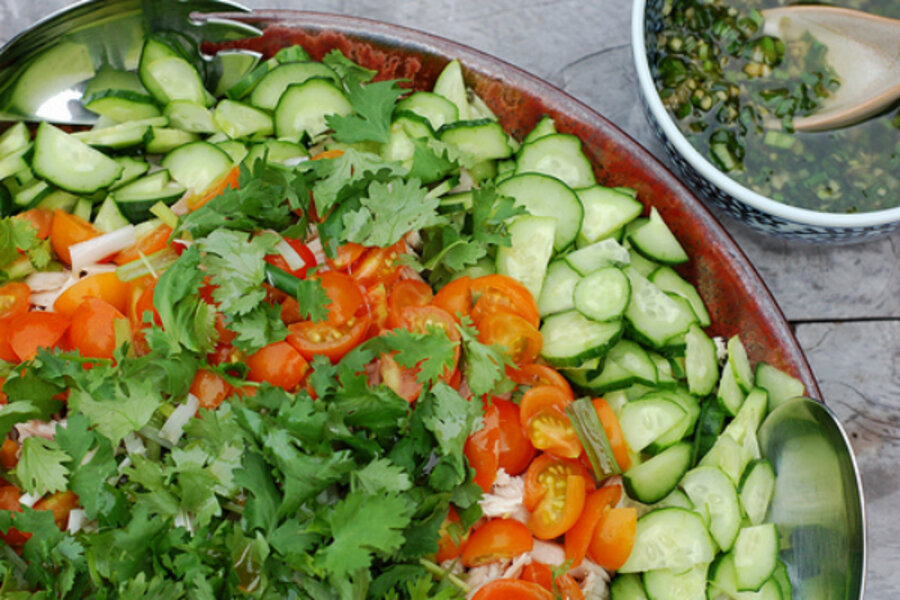Hainanese chicken with rice
Loading...
In my never-ending quest to use up the cucumbers that are spilling out of our garden on a daily basis, I remembered this lovely dish that I had not made in many years. It's a variation on a one-pot meal that yields a beautiful, composed salad served with a gingery dipping sauce that is so fresh and flavorful it's rather addictive.
The recipe hails from the island of Hainan in the South China Sea and variations on it are also popular in Thailand, Malaysia, and Singapore. I learned about it via a Mark Bittman column in the New York Times back in 2008.
In addition to being a very tasty way to showcase a bunch of fresh-picked, wonderfully crunchy cucumbers, it's a lovely way to feed a crowd. It earned rave reviews when I made it for dinner recently.
I love the mix of flavors – ginger, garlic, scallions, cilantro – and the mix of textures, crunchy cucumbers, juicy tomatoes, tender, poached chicken.
The concept is simple. You start by poaching a whole chicken in a big pot of gingery, garlicky water. Then you take the bird out to cool, leaving you with a big pot of gingery, garlicky chicken stock.
Next you cut up some shallot or onion and garlic and sauté them for a few minutes before adding the rice and sautéing that for a minute or two. Then you add some of that nice, flavorful stock you've created in lieu of water.
An important aside: if you have the freezer space, freeze whatever stock you have left over and use it next time you make this dish for even more flavorful chicken and rice. If you keep on doing this you'll end up with a kind of "master stock" that will really knock your socks off.
While the rice is cooking, you shred the meat. This is no small task! It took me about half an hour to pick the meat off my chicken although it was a whopper of a bird – more like a small turkey. By the end of the process, I had chicken under all my fingernails – not the most pleasant sensation. Fortunately, I am washable. And I own a nailbrush.
Then you whip up a simple but surprisingly addictive sauce of peanut oil, fresh ginger, scallions, a little rice mirin, and some soy sauce. I like to do this a little bit in advance to allow some time for the flavors to meld. A note of caution to you: Do not skimp on the dipping sauce! It's the key to the whole dish so you do not want to run out of it.
While the flavors are meeting and greeting over in dipping sauce land, chop up those cucumbers, tomatoes, scallions and cilantro.
Now you're ready to compose your dish. Start by mounding the rice in the center of a large platter, top it with the shredded chicken, then arrange the cucumbers, tomatoes, scallions and cilantro in a sort of edible mandala. Serve your masterpiece with copious amounts of the ginger-scallion dipping sauce.
Hainanese Chicken with Rice
lightly adapted from the New York Times
Serves 4-8
1 whole (3- to 4-pound) chicken, trimmed of excess fat
Several cloves smashed garlic, plus 1 teaspoon minced garlic
Several slices fresh ginger, plus 1 tablespoon minced ginger
1/2 cup peanut oil, or neutral oil, like corn or canola
3 shallots or a small onion, roughly chopped
2 cups long-grain rice (I used an organic white basmati)
1/2 cup minced scallions
2 cucumbers, sliced (peel them if they're from the supermarket but it's not necessary if they're from a farm or garden near you)
2 tomatoes, sliced
Chopped fresh cilantro leaves
2 tablespoons sesame oil
2 teaspoons rice mirin
2 teaspoons soy or tamari sauce
1. Place the chicken in a large pot along with the smashed garlic, sliced ginger and a generous pinch of salt and cover it with water – just enough to submerge it. Cover it and bring the water to a boil then turn it down to medium and let it simmer for 10 minutes. Turn the heat off and leave the bird in the pot for 45 minutes to an hour, covered, or until it is cooked through. I was dealing with a rather oversized beast of a bird so I just extended all the cooking times by a bit. a large pot of water to a boil and salt it. Remove the chicken from the pot, leaving the stock and let the bird cool to room temperature.
2. Make the dipping sauce using 1/4 cup peanut oil, the minced ginger, half the scallions, a large pinch of salt, the soy sauce and rice mirin. Set it aside.
3. Put 1/4 cup peanut or other neutral oil in a large skillet over medium heat. When it's hot, add the minced garlic and the shallots or onions, cook, stirring occasionally, until lightly browned, about 4-5 minutes. Add the rice (I did not wash mine and it turned out great) and cook, stirring often for 2-3 minutes. Add 4 cups of the reserved chicken stock and bring to a boil, then reduce the heat to low and cover. Cook for about 20 minutes, until the rice has absorbed all the liquid. Stir in salt and pepper to taste.
4. While the rice is cooking, shred or chop the chicken, discarding the skin. Mound the rice on a large platter and top with the chicken, then decorate with the cucumbers, tomatoes, scallions and cilantro. Sprinkle the sesame oil over it all and serve with the dipping sauce.
Related post on The Garden of Eating: Braised Chicken with Onions, White Wine & Mustard








